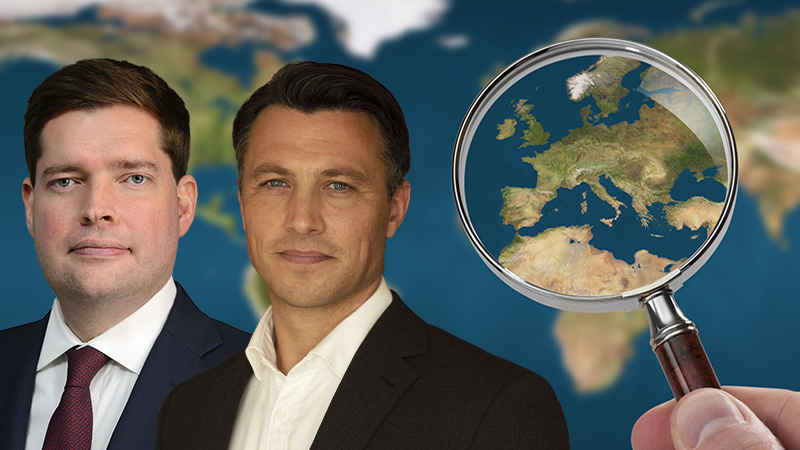With the European football championships just finished in Germany and the Olympic Games being hosted in Paris, all eyes in the sporting world this summer are on Europe.
Yet while it may be the sport grabbing the spotlight, quietly behind the scenes European equities have been enjoying their own success story in 2024. Year-to-date the MSCI Europe ex UK Index is up 7.5% in pound sterling terms, while in local currency terms the index is 10.8% which is not far behind a 13.5% return from the MSCI World Index (also in local currency terms).
With politics playing a big role in Europe this year, the real question is can this performance be maintained and what is the outlook for European equities going forward?
In this month’s portfolio constructor head-to-head James Sullivan (pictured right), head of Tyndall Partnerships, likens investing in Europe to a certain England midfielder, while Marcel Stotzel (pictured left), European portfolio manager at Fidelity, explains why despite being cautious in the short-term this is not stopping him being fully invested.
James Sullivan, head of Tyndall Partnerships
After years of talking and posturing, June 2016 was finally upon us, and we were left facing one of two outcomes: in or out. As the evening closed in, one could sense the tension in the air for what was a pivotal, make-or-break moment, and the outcome of which created shockwaves across Europe and was front page news around the globe.
Despite taking an early lead through a Wayne Rooney penalty, England lost 2-1 to Iceland, a country with a population of less than 400,000, and exited the 2016 European Championships with their tails between their legs.
A few days earlier, there was also a referendum that led to the withdrawal of the United Kingdom from the European Union.
It was, in fact, the latter landmark occasion that was felt harder within financial circles, and sentiment towards investing in the pan-European markets appeared to wane. The EuroStoxx immediately suffered significant bouts of volatility before finishing the calendar year modestly positive at 4.8%, albeit around half that of the US and global markets.
Despite this relatively brief moment of ‘risk off’, if we observe European earnings per share (EPS) growth since 2016 in local currency, the EuroStoxx index has quite remarkably outstripped that of the S&P 500. As a result, the market today is barely any more expensive than it was in 2016 on a Price Earnings (PE) basis, despite the index being up over 100% since then. In fact, over the past three years, it has surprisingly outperformed the S&P 500.
With the exception, perhaps, of some of the luxury goods companies domiciled in Europe – Louis Vuitton, Hermès, and Dior – the European market is not as ‘sexy’ as some, notably, the more dynamic US indices. However, it is incredibly resilient and offers characteristics that provide great diversification to portfolios.
It is, perhaps, the Declan Rice of investable markets: it leaves the limelight to others, probably wears traditional black boots, and drives a high-specification Volvo.
Within Tyndall, having been modestly overweight Europe and benefitted from being so, we are now ‘in line’ with the benchmark, sourcing our exposures through a combination of passive and active funds.
Given the relative cheapness of the market, our first objective was to buy the beta, which is exactly what the passive fund provides. We then complemented it with one of two active funds, subject to the mandate.
See also: Head to head: Chinese equities come back from the brink
The first fund we have used is the EdenTree Responsible and Sustainable European Equity fund. The fact that it is a green-labelled fund is neither here nor there and should not distract from the fact that it is a solid fund that delivers robust numbers time and again. It harbors a larger-cap bias, through a value-esque lens and targets companies that also make a positive contribution to society and the environment.
The second fund we use is the Liontrust European Dynamic fund, which adopts the Liontrust Cashflow Solution investment process. This process is based on the belief that cash flow is the single most important determinant of shareholder returns. The fund is neither permanently growth nor value-oriented; rather, it switches between the two styles based on market conditions.
We do not profess to own the best funds all the time, as defining ‘best’ is very subjective. However, as a blend, these three instruments work well together to deliver market beating returns with a sensible level of volatility. A little like a midfield three for England, where someone needs to sit back – possibly two, depending on the opposition – while one is free to venture forward with more freedom.
A portfolio, just like a football team, would lack balance if every fund tried to achieve the same goals. Often, the formation and balance of a team are more powerful than a collection of talented individuals.
Marcel Stotzel, portfolio manager of Fidelity European Trust PLC and Fidelity European Fund
Excessive government debt, low productivity, weakening demographics. Ongoing war in Ukraine and heightened geopolitical uncertainty. It’s not hard to find reasons to be pessimistic about Europe. But the crucial thing for investors to remember is that whatever the fortunes of the continental European economy, this is very different from the outlook for companies in the region.
Longer term equity returns are primarily driven by real dividend growth, not economic growth. And what I still find amazing about the continental European equity space is that two-thirds of revenue comes from outside the region.
Just as we can expect billions from Asia, the Americas and Africa to have tuned into the Euro 2024 football championships to see many of the best players football has to offer, so the rest of the world remains an eager buyer of European goods and services. Which in many cases are best in class, competing against international peers on the global stage.
Furthermore, as bottom-up stockpickers, we can be selective about the European companies we hold. In continental Europe, the average quality of companies is roughly the same as in the US, but the dispersion between the lowest and highest quality firms is far greater. This makes it very fertile ground for bottom-up stock selection.
See also: Head to head: Lost property
Europe also looks attractive in terms of long-term valuations; in contrast the US looks expensive even when excluding the big tech names. The fluctuations in the best regional performers we have seen over recent decades (Japan in the 1980s, America in the 90s, China and EMs in the 00s and the US again over the last 10+ years) could be an argument for reducing US exposure and allocating to more attractively valued regions.
Our goal is to find companies with the ability to grow dividends sustainably over a three-to-five year horizon, trading at reasonable prices. Portfolio turnover is very low; we have owned around half the stocks in the strategy for a decade. In keeping with the low turnover, our overall positioning hasn’t changed that much recently, and we aim to keep relative sector exposures to +/-5% of the benchmark, which mitigates a lot of macro factor risks.
We have an overweight to IT – mainly in software – where companies are very cash generative and benefitting from trends like businesses’ ongoing migration to the cloud. Industrials remain the biggest underweight, as we’ve struggled to find capital goods business which fit our criteria, while in the short-term new orders are slowing, which could feed into reduced valuations.
Our near-term outlook is more cautious, given factors like an inverting yield curve – a traditional harbinger of recession, albeit with unpredictable timing – and onerous refinancing requirements for consumers and businesses. Western economies remain highly dependent on consumer spending, and US data is looking increasingly weak on this front. Particularly for lower end consumers. With these macro headwinds in mind, we are sticking to our tried and tested formula of picking stocks that we feel have limited downside.
As many a football manager can attest, strikers win matches, but rock-solid defence wins tournaments. We always remain fully invested, as markets should rise over time. Any volatility we do see caused by macroeconomics/politics can present good buying opportunities for stocks we either already hold or are interested in acquiring.
Europe continues to offer a fantastic range of investment opportunities across different industries. This gives us the opportunity to continue delivering long-term outperformance versus not just the benchmark, but other regions as well.








